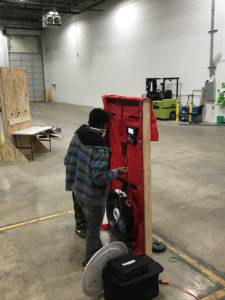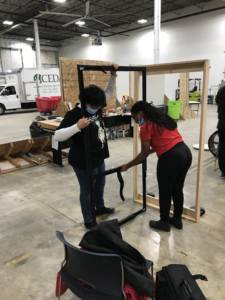Lessons from the Green Generation Workforce Development Initiative

A new program in the Chicago area called the Green Generation Workforce Development Initiative is helping high school students prepare for quality, local careers in the growing green buildings sector. It’s also leveraging a new tool to help students and their parents visualize the resulting career opportunities the students can pursue.
Energy efficiency jobs are in high demand, with one 2020 study finding that 91% of construction employers in energy efficiency reported difficulty filling positions. These jobs can also play an important role in addressing community needs, such as by reducing energy costs for struggling households and making buildings more sustainable. Recruitment for the program focused on disadvantaged communities, with an emphasis on students of color not attending STEM schools.
“[We’re] focusing heavily on equity,” said John Pady, one of the program’s leaders. “We have to change our community by the foundation of our youth. That’s why we chose to work with high school kids.”
One of the program’s intro sessions focused on helping the students, and their parents, understand the diversity of jobs available in the green buildings and energy efficiency sector and the breadth of career options the program opens up. To do this, they used a new tool designed specifically for this purpose by the Interstate Renewable Energy Council: the Green Buildings Career Map. The Map is an interactive online resource for exploring energy efficiency jobs.
We sat down with one of the program’s leaders, John Pady, Chief Expansion Officer at CEDA, to learn more about the program—and how career maps can help teachers and trainers effectively communicate the value of different education paths and get students and parents engaged.
About the Program
 The Green Generation Workforce Development Initiative provides technical training to develop energy efficiency job skills, including helping the students obtain industry certifications. It also helps students advance their leadership and analytical skills. The Initiative was developed in partnership by the Community and Economic Development Association of Cook County, Inc. (CEDA), the University of Illinois, and Urban Efficiency Group. Through the program, a cohort of high school students will gain training and leadership skills to become home performance professionals.
The Green Generation Workforce Development Initiative provides technical training to develop energy efficiency job skills, including helping the students obtain industry certifications. It also helps students advance their leadership and analytical skills. The Initiative was developed in partnership by the Community and Economic Development Association of Cook County, Inc. (CEDA), the University of Illinois, and Urban Efficiency Group. Through the program, a cohort of high school students will gain training and leadership skills to become home performance professionals.
The first cohort, which kicked off this summer with a seven-week training program, includes 11 students from Thornton Township High School District 205. The students had just completed their freshman year of high school when they enrolled in the four-year program. They’ll continue to be engaged throughout the school year through Saturday sessions once or twice a month, and return for more in-depth summer sessions in future years.
One unique aspect of the summer program is that the students earned two professional certifications from the Building Performance Institute (BPI). They earned BPI’s Air Leakage Control Installer and the Infiltration and Duct Leakage certifications. The students are the youngest individuals to earn these certifications, says John.
These kinds of certifications can significantly improve employment outcomes by demonstrating knowledge and experience to employers, as well as interest in and commitment to the field, meaning these students will already have a leg up in the job market when they graduate high school.
Using Career Maps to Communicate the Career Value of Education and Training
John says that having a career map that showed the breadth of jobs in this sector made a significant difference in helping the students understand the opportunities that the program could open up for them, and how their careers in the energy efficiency sector could progress over time. It also helped their parents understand what their children were working toward through the program.
“We also had a session that was carved out to show them all of the different vertical career tracks that are available within this field,” says John. “You don’t have to just be an energy auditor or a QCI [quality control inspector], you can be an engineer, an architect, a director, office support… There are so many different verticals within the green space; we wanted to ensure that they understood that.”
“As we were preparing for this topic, we were searching for the best ways to illustrate that and doing research, compiling salaries, earning potential, etc. when we came across the Green Buildings Career Map.”
“So, during the session, we went to the website and pulled up the Green Buildings Career Map and used it to really visualize [the options] to the students so that they could understand—and so that their parents could understand—that what they were going to embark on over the next four years is something that can lead to sustainable, meaningful, and gainful employment.”
Career Maps Can Help Engage Students – Whether or Not They’re Targeting College

John also noted that the Map was helpful for the students whether or not they thought they wanted to go to college. The Green Buildings Career Map highlights many “New-Collar Jobs” that may not require a traditional four-year college degree—instead relying on certifications, on-the-job trainng, technical education, and other paths—making it a fit for students who may not want to attend college.
For other students targeting college, John says the Map was also beneficial in helping them to understand that the certifications they would gain in the program were still beneficial for their career track.
“For the kids that were really interested in higher education, we wanted them to understand that it was still important for them to get these certifications. If you’re going to go into this green space and really have the fundamental understanding to be a good leader, you have to understand what your team does outside of yourself. It was just so helpful to have that platform to visualize it to them. Then, it’s tangible to say, ‘here’s this vertical with architects and engineers’ and ‘here’s how that supports higher education for your future.’”
Conclusion
The Green Generation Workforce Development Initiative’s use of the Green Buildings Career Map offers lessons for other training and education programs as well. By providing students with a framework for understanding what they could do in the future with certain skills, career maps can help spark excitement among students about what they are learning.
Additionally, career maps can help build support among parents for career-track programs like this one. Parental support is a powerful factor in student success so resources that help parents understand the long-term value of a training program or education track can help facilitate buy-in that will help students thrive.
Given the energy efficiency focus of the Green Generation Workforce Development Initiative, the Green Buildings Career Map was a great fit for these students. However, there are also career maps available for other energy career tracks including the Solar Career Map, focused on jobs related to solar energy, and the Careers in Climate Control Technology (HVAC/R) Map, focusing on jobs in HVAC and refrigeration.
For educators and trainers exploring energy-related topics with students, these resources can be a great way to connect your curriculum to students’ future careers!
Explore the Green Buildings Career Map Here!
